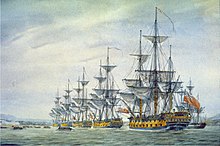HMS Centurion (1774)
 Defence of the Centurion in Vizagapatam Road, 15 September 1804, by Francis Sartorius (the younger) after a sketch by Sir James Lind
| |
| History | |
|---|---|
| Name | HMS Centurion |
| Ordered | 25 December 1770 |
| Builder | Barnard & Turner, Harwich |
| Laid down | May 1771 |
| Launched | 22 May 1774 |
| Completed | By 9 September 1775 |
| Fate |
|
| General characteristics | |
| Class and type | 50-gun fourth rate |
| Tons burthen | 1,044 11⁄94 (bm) |
| Length |
|
| Beam | 40 ft 5 in (12.3 m) |
| Depth of hold | 17 ft 3+1⁄2 in (5.27 m) |
| Propulsion | Sails |
| Sail plan | Full-rigged ship |
| Complement | 350 |
| Armament |
|
HMS Centurion was a 50-gun
During the war with America, Centurion saw action in a number of engagements and supported British forces in the Caribbean and the North American coasts. Spending the period of peace either serving as a flagship in the Caribbean or laid up or under refit in British dockyards, she was recommissioned in time to see action in the wars with France, particularly in the East Indies.
Her most important action came in the Battle of Vizagapatam in 1804, in which she fought against the French squadron of Contre-Admiral Charles-Alexandre Durand Linois that consisted of a 74-gun ship, and two frigates. Despite sustaining severe damage, she continued fighting, and survived the assault by the considerably heavier forces.
Returning to Britain shortly afterwards, she was refitted and transferred to
Construction
Centurion was ordered on 25 December 1770 and laid down in May 1771 at the yards of Barnard & Turner, of Harwich.[1] She was launched on 22 May 1774 and had been completed by 9 September 1775.[1][2] She cost a total of £20,537.17.9d, including masts and rigging, with a further £4,205.16.10d spent on fitting her out for sea.[1] Centurion was commissioned in July 1775 under her first commander, Captain Richard Braithwaite.[1]
American War of Independence

Under Braithwaite, Centurion sailed to North America in late 1775, and was present at the occupation of
After a period spent being repaired and refitted at
Inter-war period
After a year spent laid up, Centurion began a Great Repair at Woolwich in December 1784, which was completed in December 1787. She returned to active service in February 1789, as the flagship of Rear-Admiral Philip Affleck, with William Otway as her captain.[1] Otway sailed her to Jamaica in May 1789, returning to Britain in August 1792, where she underwent another repair and refit, this time at Chatham.[1] She was recommissioned during this work, in November 1792, under Captain Samuel Osborn.[1] With the dockyard completed by January 1793 she sailed to the Leeward Islands in February.[1]
French Revolutionary and Napoleonic Wars
After some time spent on the Leeward islands, Centurion sailed to the
Captain
Centurion returned to Batavia in August 1800, and on 23 August she, with Sybille, Daedalus, and Braave, captured or destroyed several Dutch vessels at Batavia Roads. One vessel, a Dutch brig, the Royal Navy took into service as Admiral Rainier.[1]
Battle of Vizagapatam
By September 1804, Admiral
The three main French ships, the 74-gun
Both nations claimed the encounter as a victory, the French for the capture of the East Indiaman and the British for the survival of Centurion in the face of overwhelming French numerical superiority.[9]
Retirement from active service
Centurion did not remain much longer in the East Indies, being sent home in November as needing an extensive repairs, due at least in part to the damage inflicted by an infestation of
Centurion was duly fitted at Chatham for service as a
Fate
Centurion was finally hulked in 1817, in which state she spent the next seven years. She sank at her moorings on 21 February 1824; was raised and broken up in 1825.[1][2]
Notes
Citations
- ^ a b c d e f g h i j k l m n o p q r s t u v w Winfield 2007, p. 150
- ^ a b Colledge. Ships of the Royal Navy. p. 63.
- ^ a b c Marshall (1827), Supplement, Part 1, p.142.
- ^ Gardiner. Fleet Battle and Blockade. p. 115.
- ^ James. Naval History of Great Britain. Vol. 3. p. 277.
- ^ a b James. Naval History of Great Britain. Vol. 3. p. 279.
- ^ Clowes. The Royal Navy, A History. Vol. 5. p. 349.
- ^ James. Naval History of Great Britain. Vol. 4. p. 150.
- ^ James. Naval History of Great Britain. Vol. 3. p. 280.
References
- ISBN 1-86176-014-0.
- ISBN 978-1-86176-281-8.
- Gardiner, Robert, ed. (2001) [1996]. Fleet Battle and Blockade. Caxton Editions. OCLC 50264868.
- ISBN 0-85177-907-7.
- ISBN 0-85177-908-5.
- Marshall, John (1827). . Royal Naval Biography. Vol. sup, part 1. London: Longman and company. p. 142.
- Winfield, Rif (2007). British Warships of the Age of Sail 1714–1792: Design, Construction, Careers and Fates. Seaforth. ISBN 978-1-86176-295-5.
